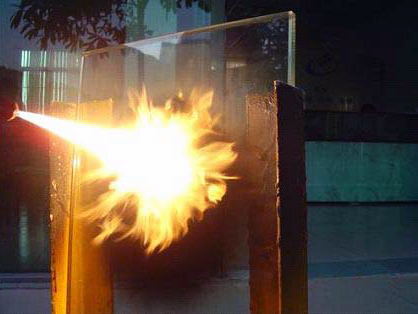- One Stop Solution
- Products
- Hot sales
- Aluminum window and door
- Contact Us
- Catalogue
Views: 7 Author: Site Editor Publish Time: 2020-03-27 Origin: Site

The invention of fire-rated glass is one of the most critical developments in the design and construction community. Depending on the type of glass, fire-rated glazing may block smoke, flames, and heat, which means architects can incorporate larger expanses of glass into stairwells, between offices and classrooms, overlooking atriums, and countless other applications while still meeting crucial safety requirements. But while it serves an important purpose, there is still some confusion around fire-rated glass. Differing terminology and varied codes can lead to questions and misinformation.
Here are some of the most common questions we receive about fire-rated glass.
Q: What is fire-rated glass?
Depending on the type, fire-rated glass may block smoke, flame, and, often, heat for 20 minutes to three hours. This allows architects to meet design goals for aesthetics and day lighting while still ensuring safety and meeting building and fire code requirements. The highly flexible product range allows nearly unlimited multi functional and aesthetic possibilities, perfectly blending with adjacent non-fire glass types. Fire-resistant glass can be used for overhead glazing, windows, sidelites, butt-joint solutions, fire-rated doors, partition walls, glass floors, or curtain walls.
Q: What are the types of fire-rated glass?
There are two types of fire-rated glazing: fire-protective and fire-resistive. There are several product options within each category. It’s important to consult with a fire-rated glass expert at Vetrotech to get the specific solution that meets your project needs.
In general, Fire-protective glass, also known as ‘glass ceramics,’ is designed to block (or compartmentalize) smoke and flames, but does not block the transfer of radiant heat. This means the glass will help keep the fire from spreading, but will not prevent heat-related injury to occupants. Examples of fire-protective-rated products are polished wired glass, specialty tempered glass, some intumescent laminates, and glass ceramic.
Fire-resistive glass is made with multiple layers of laminated glass with an intumescent chamber in between, providing an insulative layer to not only block smoke and flames, but also provide a barrier to radiant heat. This allows building occupants to exit the building without being subjected to radiant heat burns, making it suitable for egress applications such as stairwells designed with glass walls to encourage more frequent use.
Q: What type of fire-rated glazing is required under the code?
Depending on the code edition, your project could require a fire-resistant or fire-protective product. There are unique requirement differences between fire-protective and fire-resistive glass.
For example, fire-resistive glass is required for glazed assembly openings, door vision panels, and sidelites and transoms comprising greater than 25 percent of the common wall; these areas are classified as a ‘transparent wall’ and must comply with ASTM E119. Fire-resistive glass is also required for 60- to 120-minute walls, 60- to 90-minute door vision panels, and 60- to 120-minute sidelites and transoms when not in exit enclosures and passageways. Vetrotech’s experts can help you determine the right fire-rated product and solution that meets IBC regulations.
Q: Can I meet my design goals with fire-rated glazing?
Building and construction teams have many fire-rated glazing solutions to choose from with multi-functional capabilities, including glass floors, skylights, curtain walls, doors and framing. Vetrotech can even help design custom fire-rated glazing assemblies for projects with unique design and performance needs. Using clear fire-rated products like CONTRAFLAM gives architects and designers the flexibility to match aesthetics of window glass. By combining CONTRAFLAM fire-rated glass with Vetrotech’s low-profile steel fire-rated VDS frames, featuring thinner frame profile dimensions; architects and designers have a fire-rated solution that integrates with curtain wall, windows and other door and framing components.
Q: Why isn’t there a simple chart that can be used to select fire-rated products?
Fire-rated products are defined under performance-based code regulations, and products tested to the proper standards have different listed results. A simple chart couldn’t cover all possible outcomes. However, Vetrotech has an application guide[link] that to use as a starting point. Our fire-rated application experts can help you find the exact solution for your project. Reference Vetrotech's Product Resource Guide for more information
Q: What does Vetrotech recommend to put between the walls and its frames and doors jambs?
Fire-rated caulk and Mineral wool or Rockwool can be used. Material must be listed for use in fire-rated applications. Always follow instruction sheets, shop drawings, and UL guidelines.
Q: What does Vetrotech recommend for fire-rated caulking? What does one do if custom color caulk is required?
Vetrotech does not specify a brand or type; any listed fire-rated caulk can be used with Vetrotech fire-rated glazing. If desired, a cosmetic sealant can be used in addition for aesthetic purposes.
Q: Does fire-rated glass look different than traditional glass?
Some fire-rated glass will have an amber cast to it. However, manufacturers continue to improve the look and visibility of fire-rated products. For example, Vetrotech’s Keralite Select
features a patent-pending surface polishing technology with advanced composition to create sharper, more accurate color-viewing. It has a color-rendering index of 97.1 (out of 100), a high R96a value. The closer the CRI value (Ra) is to 100, the better or truer the color rendering.
| | NO 1506, XINYE ROAD, SHAPING TOWN, HESHAN CITY, JIANGMEN, GUANGDONG, CHINA |
| | +8613750315014 |
| |